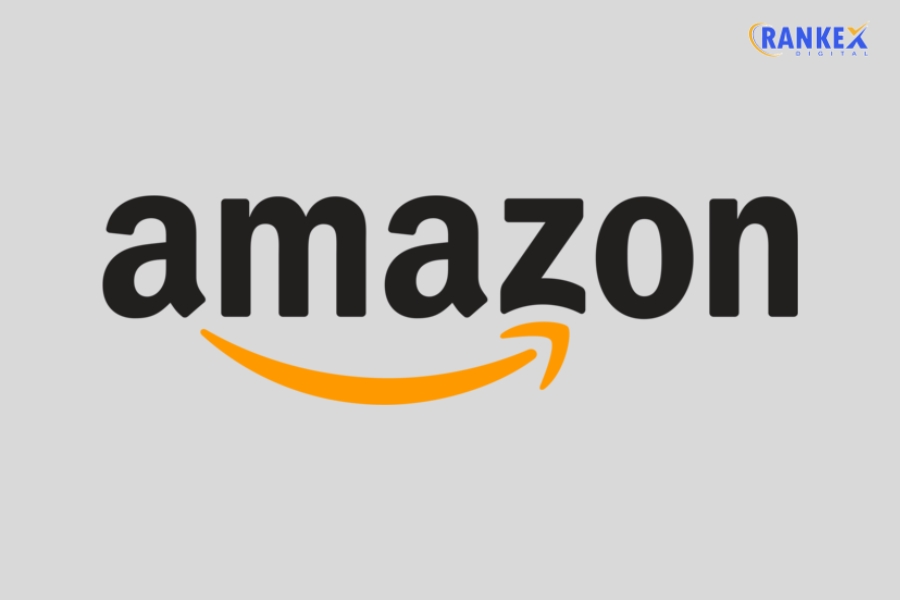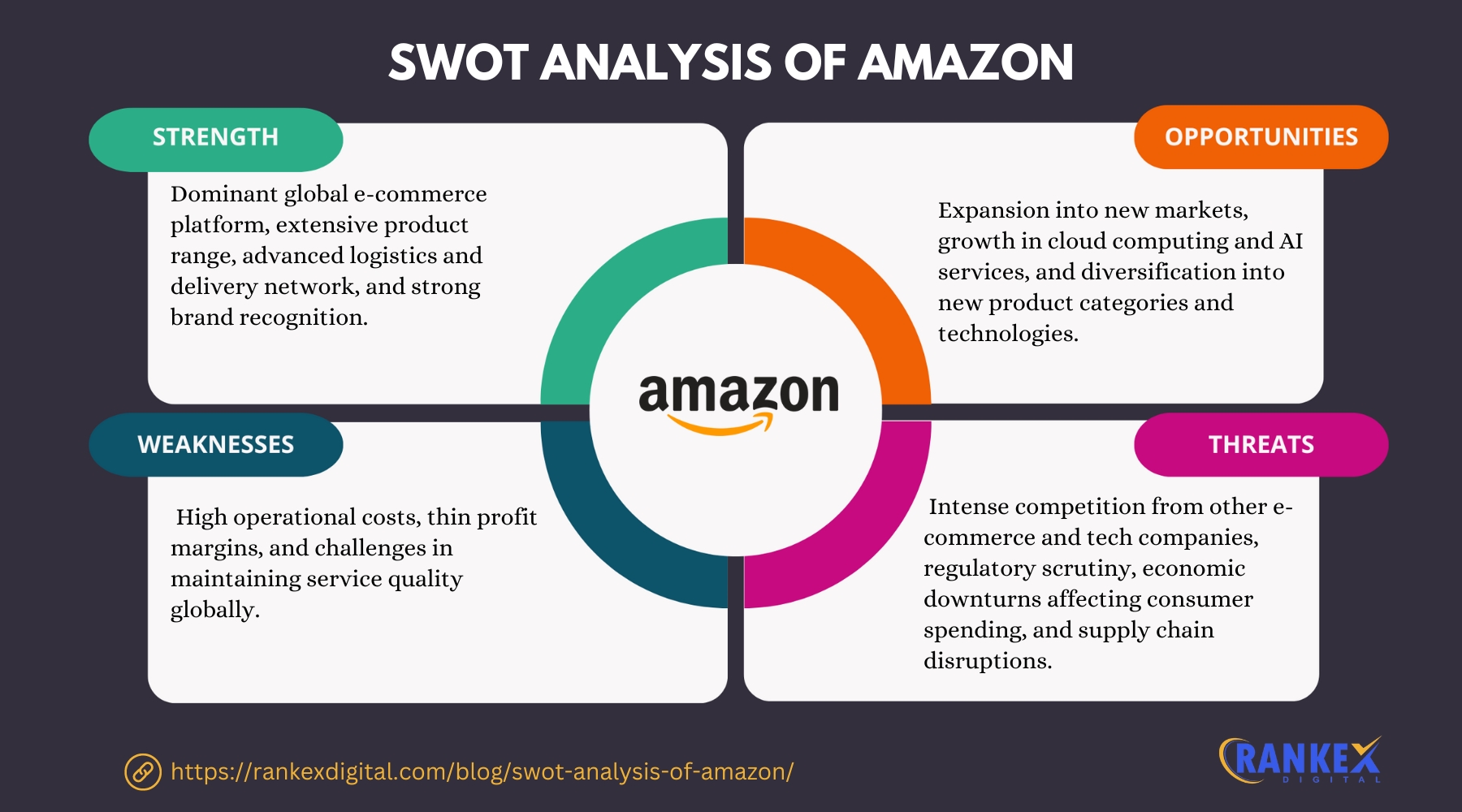Amazon, founded by Jeff Bezos in 1994, has grown into one of the world’s largest and most diversified companies.
As a leader in e-commerce, cloud computing (AWS), artificial intelligence, and digital streaming, Amazon has established itself as a major player in the global tech and retail industries.
This updated SWOT analysis of Amazon in 2025 highlights the company’s strengths, weaknesses, opportunities, and threats in an increasingly competitive market.
Table of Contents
Overview of Amazon

| Founder | Jeff Bezos |
|---|---|
| Year Founded | 1994 |
| Headquarters | Seattle, Washington, USA |
| Industry | E-commerce, Cloud Computing, Technology |
| Annual Revenue | $514 Billion (FY 2023) |
| Number of Employees | 1.5+ million |
| Global Reach | 100+ countries with multiple business divisions |
Amazon’s diversified business model includes its core e-commerce operations, Amazon Web Services (AWS), and ventures into digital content, smart home products, and logistics. It is widely recognized for its customer-centric approach, extensive product selection, and innovative technology solutions.
SWOT Analysis of Amazon

Strengths of Amazon
- Global Market Leader in E-commerce
Amazon’s dominant position in e-commerce is unparalleled, with a global reach that includes millions of customers across multiple countries. The platform offers a vast selection of products and services, making it the go-to destination for online shopping. - Amazon Web Services (AWS)
AWS is a key growth driver, holding a leading market share in cloud computing. AWS’s infrastructure powers countless businesses worldwide, from small startups to large enterprises, contributing a significant portion of Amazon’s revenue. - Customer-Centric Innovation
Amazon is renowned for its focus on enhancing customer experience. Innovations like one-click ordering, voice shopping via Alexa, Prime delivery, and personalized recommendations set Amazon apart from competitors. - Extensive Supply Chain & Logistics Network
Amazon’s massive global supply chain and logistics infrastructure allow for efficient and fast delivery services, including same-day and next-day options. Its advanced warehouse automation and last-mile delivery capabilities provide a competitive edge. - Brand Loyalty through Amazon Prime
Amazon Prime membership provides access to exclusive deals, free shipping, and streaming services, fostering high customer loyalty. As of 2025, Prime has more than 200 million members worldwide.
Weaknesses of Amazon
- High Operating Costs
Amazon’s vast network of warehouses, delivery services, and employee base requires substantial investment, leading to high operational costs. This limits profitability in certain divisions, particularly the e-commerce sector. - Labour Relations & Employee Welfare Issues
Amazon has faced criticism and legal challenges related to worker conditions, particularly in its warehouses. These labour disputes and concerns over employee welfare tarnish the company’s reputation. - Over-Reliance on AWS for Profits
While AWS is highly profitable, Amazon’s core e-commerce business has lower margins. A significant portion of Amazon’s profitability stems from AWS, making it dependent on the continued growth of its cloud services. - Environmental Impact
As Amazon grows, so does its carbon footprint. The company has faced increasing scrutiny for its environmental impact, including packaging waste, energy consumption, and emissions from its delivery operations. - Antitrust & Regulatory Challenges
Amazon faces regulatory scrutiny in various regions due to concerns over anti-competitive practices, data privacy, and its overwhelming influence in both retail and cloud computing sectors.
Opportunities for Amazon
- Expansion of AWS
The demand for cloud computing services continues to rise, particularly in industries like healthcare, finance, and artificial intelligence. Amazon can capitalize on this trend by further expanding AWS’s capabilities and client base. - Growth in International Markets
Amazon still has significant growth potential in emerging markets like India, Southeast Asia, and Africa. With increased localization efforts and strategic investments, Amazon can expand its customer base in these regions. - Development of New Technologies
Amazon has been at the forefront of innovations such as artificial intelligence, automation, and machine learning. Further investments in these technologies could lead to advancements in product delivery, customer experience, and digital services. - Sustainability Initiatives
By ramping up its commitment to sustainability, including reducing carbon emissions and increasing the use of renewable energy, Amazon can improve its brand image and meet the rising demand for eco-friendly business practices. - Healthcare & Fintech Expansion
Amazon’s foray into healthcare (Amazon Pharmacy) and financial technology (Amazon Pay) offers new avenues for growth. By leveraging its existing customer base, Amazon can diversify into these high-potential sectors.
Threats to Amazon
- Intense Competition in E-commerce
Amazon faces fierce competition from global players like Alibaba, Walmart, and JD.com, as well as local e-commerce platforms in various regions. This competition puts pressure on market share and pricing strategies. - Regulatory Pressures & Antitrust Lawsuits
Growing antitrust and regulatory scrutiny, particularly in the U.S. and Europe, could lead to fines, restrictions on business practices, or even forced divestitures. This could impact Amazon’s market dominance and growth trajectory. - Rising Labor Costs
The ongoing push for higher wages and better working conditions, especially in developed markets, could increase Amazon’s operating costs. This may affect profitability in certain segments, particularly logistics and delivery. - Supply Chain Disruptions
Global supply chain disruptions, whether due to geopolitical tensions, pandemics, or raw material shortages, can severely affect Amazon’s operations, particularly its e-commerce and delivery services. - Cybersecurity Risks
As a technology-driven company, Amazon faces significant cybersecurity risks. A data breach or system failure could not only harm its reputation but also result in financial losses and legal consequences.
Competitors of Amazon
- Alibaba Group
Alibaba is Amazon’s primary competitor in China and other Asian markets. With its dominance in e-commerce and cloud services (AliCloud), it rivals Amazon’s global reach. - Walmart
Walmart competes with Amazon in the U.S. and international markets through its robust e-commerce platform and physical stores, which offer a hybrid shopping experience. - Microsoft Azure
In the cloud computing space, Microsoft Azure competes directly with AWS, capturing a significant share of the cloud services market, particularly in enterprise solutions. - Google Cloud
Google Cloud competes with AWS in cloud computing, offering innovative AI and machine learning services, often used by enterprises and tech firms globally. - JD.com
As a major player in China’s e-commerce landscape, JD.com poses a significant challenge to Amazon in terms of logistics, product range, and competitive pricing. - Flipkart
Flipkart competes with Amazon in the Indian market with the e-commerce marketplace with all the electronics, laptops, fashion, households and many more.
Wrapping it Up
Amazon’s strengths, including its market leadership, technological innovation, and extensive logistics network, position it as a dominant force in the global marketplace. However, challenges such as regulatory scrutiny, labour disputes, and rising competition demand that Amazon continuously adapts to an evolving landscape.
By leveraging opportunities in cloud computing, international markets, and new technologies, Amazon can continue to thrive, despite the threats posed by regulatory changes and competitive pressures.
Frequently Asked Questions
1. What is Amazon’s biggest strength?
Amazon’s biggest strength is its dominance in e-commerce and cloud computing, particularly through Amazon Web Services (AWS).
2. What are Amazon’s weaknesses?
Weaknesses include high operating costs, labour relations issues, over-reliance on AWS for profitability, environmental impact, and regulatory challenges.
3. What opportunities exist for Amazon in 2025?
Opportunities for Amazon include expanding AWS, growing in international markets, developing new technologies, improving sustainability, and entering sectors like healthcare and fintech.
4. What threats does Amazon face?
Amazon faces threats from intense competition, regulatory pressures, rising labour costs, supply chain disruptions, and cybersecurity risks.
5. Who are Amazon’s top competitors?
Amazon’s top competitors include Alibaba, Walmart, Microsoft Azure, Google Cloud, and JD.com.











